A model tourist village is planned to be opened and operated within one year in Tatkon Township, Nay Pyi Taw Council Area, according to a responsible official from the Myanmar Tourism Federation.
The village in question is Nyaungpintha, located in Makyeepin village-tract, Tatkon Township. It was previously affected by flooding and will now be reconstructed and developed into a model tourist village.
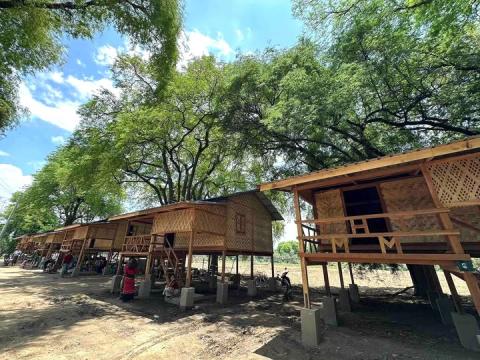
A model tourist village is planned to be opened and operated within one year in Tatkon Township, Nay Pyi Taw Council Area, according to a responsible official from the Myanmar Tourism Federation.
The village in question is Nyaungpintha, located in Makyeepin village-tract, Tatkon Township. It was previously affected by flooding and will now be reconstructed and developed into a model tourist village.
“Around one hour’s drive from Nay Pyi Taw Hotel Zone, Nyaungpintha village is being developed by our tourism federation as a model tourist village. During the floods, the entire village was destroyed. Now that it has been rebuilt, the federation has taken charge of the site, reconstructed the houses, and drawn up a village plan. Construction was completed last month, and ownership has been handed back to the residents.
We are now working to develop the area as a rural-based tourist destination where visitors can come and explore,” the official stated.
He continued, “This will be implemented step by step. When international tourists come to Nay Pyi Taw, they’ll be able to experience the charm of rural life. We’re planning for either overnight or day trips. It’s about enjoying traditional rural meals, relaxing, and receiving traditional massages. It will become an excellent destination for one-day or overnight trips in Nay Pyi Taw. We’re currently working on this. If everything goes smoothly, it should be ready for the upcoming tourism season”.
At present, efforts are ongoing to implement the tourism project. Besides enjoying traditional rural cuisine and relaxation, plans are also underway for visitors to participate in local livelihoods. The village is bordered by a picturesque stream and lush fields, offering an immersive rural experience. — ASH/KNN
Source: The Global New Light of Myanmar
A model tourist village is planned to be opened and operated within one year in Tatkon Township, Nay Pyi Taw Council Area, according to a responsible official from the Myanmar Tourism Federation.
The village in question is Nyaungpintha, located in Makyeepin village-tract, Tatkon Township. It was previously affected by flooding and will now be reconstructed and developed into a model tourist village.
“Around one hour’s drive from Nay Pyi Taw Hotel Zone, Nyaungpintha village is being developed by our tourism federation as a model tourist village. During the floods, the entire village was destroyed. Now that it has been rebuilt, the federation has taken charge of the site, reconstructed the houses, and drawn up a village plan. Construction was completed last month, and ownership has been handed back to the residents.
We are now working to develop the area as a rural-based tourist destination where visitors can come and explore,” the official stated.
He continued, “This will be implemented step by step. When international tourists come to Nay Pyi Taw, they’ll be able to experience the charm of rural life. We’re planning for either overnight or day trips. It’s about enjoying traditional rural meals, relaxing, and receiving traditional massages. It will become an excellent destination for one-day or overnight trips in Nay Pyi Taw. We’re currently working on this. If everything goes smoothly, it should be ready for the upcoming tourism season”.
At present, efforts are ongoing to implement the tourism project. Besides enjoying traditional rural cuisine and relaxation, plans are also underway for visitors to participate in local livelihoods. The village is bordered by a picturesque stream and lush fields, offering an immersive rural experience. — ASH/KNN
Source: The Global New Light of Myanmar
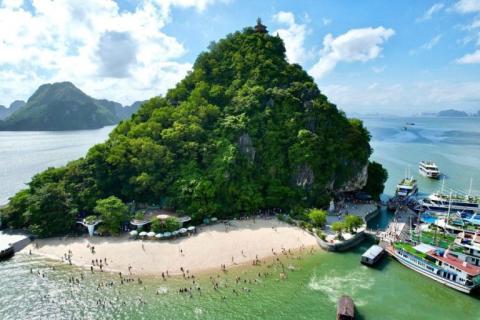
Going to the ocean in the morning with drizzle feels like a unique and different experience. By the time we left the Chinatown area in the old quarter of Hanoi, the drizzle had turned into a steady rain.
Going to the ocean in the morning with drizzle feels like a unique and different experience. By the time we left the Chinatown area in the old quarter of Hanoi, the drizzle had turned into a steady rain.
The Chinatown in old Hanoi, Vietnam, is similar to Yangon’s Chinatown, but the structure and style of the houses are noticeably different. The homes are narrow in the front and stretch deep toward the back, typically no more than three stories high. According to local tradition, if a son is born, a ten-foot-wide plot is inherited, so these narrow, ten-foot houses can often be seen, similar to some homes in areas like Thakayta, South Okkalapa, and Dagon Myothit (South) townships in Yangon. Narrow alleys, compact homes, small eateries lining the streets, large coffee shops, swarms of motorbikes zipping back and forth, and a variety of cars emerging from every corner – these are likely iconic scenes that define Hanoi’s Old Quarter Chinatown.
Leaving behind Chinatown, as we ascended onto the highway, the sight of the grand and beautiful new city of Hanoi, with its towering buildings, immediately captivated my attention. Putting aside the multilayered roads and colourful cars of Hanoi, as our vehicle cruised toward Ha Long Bay, my gaze was once again drawn to the expansive green fields stretching alongside the highway, where the vast, serene sea seemed to merge with the lush landscape.
Behind lush paddy landscapes
In the distance, across the vast fields spread like green carpets, neat and beautiful little buildings can be seen arranged in order. Among the wide fields, groups of rice mills, silos and agricultural machinery can be seen scattered throughout. The wide, continuous stretches of farmland, the small production roads, and the irrigation drains present a scene so orderly and well-organized that it looks like a carefully drawn map of an agricultural landscape.
In Myanmar, it’s not easy to come across vast stretches of farmland laid out in large, rectangular plots like those measured in hectares. Most genuine Myanmar farmers own less than five acres of land, so it’s rare to see large, contiguous plots suitable for big tractors to operate efficiently. For such systematically organized farmland to emerge, challenges such as the need for a stable market, favourable weather conditions, and other hurdles must be overcome. Behind the lingering question of “When will all this become a reality?” lies only a sense of quiet contemplation.
Behind the lush green rice fields, Vietnam’s rice cultivation and production are facing mounting challenges. Vietnam’s rice trade is also showing notable developments. In 2024, Vietnam became a record-breaking rice exporter, shipping 9.04 million tonnes. According to the US Department of Agriculture’s (USDA) global agriculture, supply, and demand forecast report, Vietnam is set to soon surpass Thailand to become the world’s second-largest rice exporter.
Many rice farmers in Vietnam are switching to cultivating other, more profitable crops, which has led to a decline in the country’s rice production. However, Vietnam’s rice exporters are maintaining their hold on the global rice market by importing rice from neighbouring Cambodia. As a result, by 2024, Vietnam could reach an import volume of around 4 million tonnes, potentially becoming the second-largest rice-importing country in the world. This situation, being both the second-largest rice exporter and the second-largest rice importer globally, highlights a unique aspect of Vietnam’s rice trade.
A glimpse of the land of Pearl
When the vast farmlands that once captivated the eye began to fade away, the shimmering reflection of silver light appeared, signalling the arrival at the seaside. This gave a clear sense that we had entered the coastal region. “Ha Long” was once a region known for its coal mines. Along the way, we passed through large areas where hundreds of coal transport trucks used to park. But when international tourists began to arrive at Ha Long Bay, the coal mines gradually shut down, and the entire area appeared to have transitioned to tourism. Now, as a coastal city, Ha Long is also thriving economically through its port operations and fishing industry, becoming a well-known and prosperous city.
Ha Long is famous not only for its coal mines, ports, and fishing industry but also for its pearl farming. Pearl farms built in the middle of the sea, artificial islands, and museums that display the step-by-step process of pearl cultivation and production attract many tourists.
It has only been two hours since leaving Hanoi. Although the drizzle has stopped, puddles from the rain remain. Upon entering the Ha Long area, the car made a brief stop at a place that houses restaurants, a pearl sales hall, and a pearl museum.
What is remarkable is that inside the pearl sales showroom, the pearl production process is demonstrated using small display tables. The process of extracting pearls from oysters and the step-by-step production stages are practically shown, with staff explaining everything clearly. Within the three-story building, there is a large shopping centre that includes gemstone and pearl showrooms, pearl-themed paintings and sculptures, clothing, shoes, and a wide variety of food items. In one section of the shopping centre, there is even a display where crocodile skin is shown with the actual shape of the crocodile, and various types of bags made from crocodile skin are exhibited and sold. As for the dining area, it is located entirely on the second floor.
Having just left the Pearl Museum, we soon arrived at the world-famous Ha Long Bay. It has been over two hours since leaving Hanoi. Although we were glad the rain completely stopped upon setting foot on the beach, we still could not see the sunlight.
A breathtaking cave
We are going to board the large cruise boat, Stella Luxury Cruise, docked at the shore, to explore Ha Long Bay. Approximately 50 travellers will join the journey on the three-story Stella Luxury Cruise. Since there are multiple pleasure boats at the shore heading to Ha Long Bay, we need to be careful not to get on the wrong boat, and the passengers are also quite crowded and a bit bustling.
The Stella Luxury Cruise, departing from Ha Long Harbour, embarked on its first exploratory trip to Sung Sot Cave, the largest and most breathtaking stalactite cave in the Ha Long Bay area.
Sung Sot Cave is the largest and most spectacular stalactite cave among the many limestone caves in Ha Long Bay. It is renowned by tourists worldwide and is also listed as a UNESCO World Heritage stalactite cave.
Sung Sot Cave is located on Bo Hon Island in the middle of Ha Long Bay, about a 50-minute journey from Ha Long Beach. To reach the entrance of the main cave, visitors must climb over 100 steep steps. From the large cave entrance, you have to go down again to enter the inner part of the cave. Covering a total area of over 12,000 square metres, inside Sung Sot Cave, we can see sparkling stalactites, stalagmites, and natural stone formations that resemble flowers and chandeliers.
Along the cave path, there are large halls, narrow steps for climbing, and narrow walkways where one can only pass a single file, requiring passage through gaps between rocks. Some places are wide and spacious with good airflow. Inside the limestone cave, due to sea erosion, the rock formations have taken on various shapes, resembling decorative stone sculptures. The limestone caves in Kayin State and Mon State of Myanmar are somewhat similar. In particular, Nandamu Cave from PyinOoLwin, and Bat Cave and Jasmine Cave in Kyaikmaraw town, Mon State, are quite alike. However, the Sung Sot Cave is larger and much longer.
At one location, arrangements were made to take commemorative photos, and since there was also a team available to take the photos, the tour was praised for being well-organized. Inside the great limestone cave, beautiful stone chandeliers, stone floral arrangements, and stone flower pots were illuminated and displayed with colourful spotlights. Because it was so beautiful, it was very satisfying for those who wanted to capture it in photographs.
The Sung Sot Cave in Ha Long Bay is also famous for its interesting and legendary stories, similar to other caves. In traditional Vietnamese folklore, Thanh Giong is a very famous hero who is said to have kept his battle horse and sword inside Sung Sot Cave to fight off evil spirits. Visitors can see stone carvings that closely resemble Thanh Giong’s horse and sword. Inside the cave, small cups that can be identified as the footprints of Thanh Giong’s horse further confirm the fascinating legends of the hero Thanh Giong…
TO BE CONTINUED
By Aung Sie Hein
Source: The Global New Light of Myanmar
Going to the ocean in the morning with drizzle feels like a unique and different experience. By the time we left the Chinatown area in the old quarter of Hanoi, the drizzle had turned into a steady rain.
The Chinatown in old Hanoi, Vietnam, is similar to Yangon’s Chinatown, but the structure and style of the houses are noticeably different. The homes are narrow in the front and stretch deep toward the back, typically no more than three stories high. According to local tradition, if a son is born, a ten-foot-wide plot is inherited, so these narrow, ten-foot houses can often be seen, similar to some homes in areas like Thakayta, South Okkalapa, and Dagon Myothit (South) townships in Yangon. Narrow alleys, compact homes, small eateries lining the streets, large coffee shops, swarms of motorbikes zipping back and forth, and a variety of cars emerging from every corner – these are likely iconic scenes that define Hanoi’s Old Quarter Chinatown.
Leaving behind Chinatown, as we ascended onto the highway, the sight of the grand and beautiful new city of Hanoi, with its towering buildings, immediately captivated my attention. Putting aside the multilayered roads and colourful cars of Hanoi, as our vehicle cruised toward Ha Long Bay, my gaze was once again drawn to the expansive green fields stretching alongside the highway, where the vast, serene sea seemed to merge with the lush landscape.
Behind lush paddy landscapes
In the distance, across the vast fields spread like green carpets, neat and beautiful little buildings can be seen arranged in order. Among the wide fields, groups of rice mills, silos and agricultural machinery can be seen scattered throughout. The wide, continuous stretches of farmland, the small production roads, and the irrigation drains present a scene so orderly and well-organized that it looks like a carefully drawn map of an agricultural landscape.
In Myanmar, it’s not easy to come across vast stretches of farmland laid out in large, rectangular plots like those measured in hectares. Most genuine Myanmar farmers own less than five acres of land, so it’s rare to see large, contiguous plots suitable for big tractors to operate efficiently. For such systematically organized farmland to emerge, challenges such as the need for a stable market, favourable weather conditions, and other hurdles must be overcome. Behind the lingering question of “When will all this become a reality?” lies only a sense of quiet contemplation.
Behind the lush green rice fields, Vietnam’s rice cultivation and production are facing mounting challenges. Vietnam’s rice trade is also showing notable developments. In 2024, Vietnam became a record-breaking rice exporter, shipping 9.04 million tonnes. According to the US Department of Agriculture’s (USDA) global agriculture, supply, and demand forecast report, Vietnam is set to soon surpass Thailand to become the world’s second-largest rice exporter.
Many rice farmers in Vietnam are switching to cultivating other, more profitable crops, which has led to a decline in the country’s rice production. However, Vietnam’s rice exporters are maintaining their hold on the global rice market by importing rice from neighbouring Cambodia. As a result, by 2024, Vietnam could reach an import volume of around 4 million tonnes, potentially becoming the second-largest rice-importing country in the world. This situation, being both the second-largest rice exporter and the second-largest rice importer globally, highlights a unique aspect of Vietnam’s rice trade.
A glimpse of the land of Pearl
When the vast farmlands that once captivated the eye began to fade away, the shimmering reflection of silver light appeared, signalling the arrival at the seaside. This gave a clear sense that we had entered the coastal region. “Ha Long” was once a region known for its coal mines. Along the way, we passed through large areas where hundreds of coal transport trucks used to park. But when international tourists began to arrive at Ha Long Bay, the coal mines gradually shut down, and the entire area appeared to have transitioned to tourism. Now, as a coastal city, Ha Long is also thriving economically through its port operations and fishing industry, becoming a well-known and prosperous city.
Ha Long is famous not only for its coal mines, ports, and fishing industry but also for its pearl farming. Pearl farms built in the middle of the sea, artificial islands, and museums that display the step-by-step process of pearl cultivation and production attract many tourists.
It has only been two hours since leaving Hanoi. Although the drizzle has stopped, puddles from the rain remain. Upon entering the Ha Long area, the car made a brief stop at a place that houses restaurants, a pearl sales hall, and a pearl museum.
What is remarkable is that inside the pearl sales showroom, the pearl production process is demonstrated using small display tables. The process of extracting pearls from oysters and the step-by-step production stages are practically shown, with staff explaining everything clearly. Within the three-story building, there is a large shopping centre that includes gemstone and pearl showrooms, pearl-themed paintings and sculptures, clothing, shoes, and a wide variety of food items. In one section of the shopping centre, there is even a display where crocodile skin is shown with the actual shape of the crocodile, and various types of bags made from crocodile skin are exhibited and sold. As for the dining area, it is located entirely on the second floor.
Having just left the Pearl Museum, we soon arrived at the world-famous Ha Long Bay. It has been over two hours since leaving Hanoi. Although we were glad the rain completely stopped upon setting foot on the beach, we still could not see the sunlight.
A breathtaking cave
We are going to board the large cruise boat, Stella Luxury Cruise, docked at the shore, to explore Ha Long Bay. Approximately 50 travellers will join the journey on the three-story Stella Luxury Cruise. Since there are multiple pleasure boats at the shore heading to Ha Long Bay, we need to be careful not to get on the wrong boat, and the passengers are also quite crowded and a bit bustling.
The Stella Luxury Cruise, departing from Ha Long Harbour, embarked on its first exploratory trip to Sung Sot Cave, the largest and most breathtaking stalactite cave in the Ha Long Bay area.
Sung Sot Cave is the largest and most spectacular stalactite cave among the many limestone caves in Ha Long Bay. It is renowned by tourists worldwide and is also listed as a UNESCO World Heritage stalactite cave.
Sung Sot Cave is located on Bo Hon Island in the middle of Ha Long Bay, about a 50-minute journey from Ha Long Beach. To reach the entrance of the main cave, visitors must climb over 100 steep steps. From the large cave entrance, you have to go down again to enter the inner part of the cave. Covering a total area of over 12,000 square metres, inside Sung Sot Cave, we can see sparkling stalactites, stalagmites, and natural stone formations that resemble flowers and chandeliers.
Along the cave path, there are large halls, narrow steps for climbing, and narrow walkways where one can only pass a single file, requiring passage through gaps between rocks. Some places are wide and spacious with good airflow. Inside the limestone cave, due to sea erosion, the rock formations have taken on various shapes, resembling decorative stone sculptures. The limestone caves in Kayin State and Mon State of Myanmar are somewhat similar. In particular, Nandamu Cave from PyinOoLwin, and Bat Cave and Jasmine Cave in Kyaikmaraw town, Mon State, are quite alike. However, the Sung Sot Cave is larger and much longer.
At one location, arrangements were made to take commemorative photos, and since there was also a team available to take the photos, the tour was praised for being well-organized. Inside the great limestone cave, beautiful stone chandeliers, stone floral arrangements, and stone flower pots were illuminated and displayed with colourful spotlights. Because it was so beautiful, it was very satisfying for those who wanted to capture it in photographs.
The Sung Sot Cave in Ha Long Bay is also famous for its interesting and legendary stories, similar to other caves. In traditional Vietnamese folklore, Thanh Giong is a very famous hero who is said to have kept his battle horse and sword inside Sung Sot Cave to fight off evil spirits. Visitors can see stone carvings that closely resemble Thanh Giong’s horse and sword. Inside the cave, small cups that can be identified as the footprints of Thanh Giong’s horse further confirm the fascinating legends of the hero Thanh Giong…
TO BE CONTINUED
By Aung Sie Hein
Source: The Global New Light of Myanmar
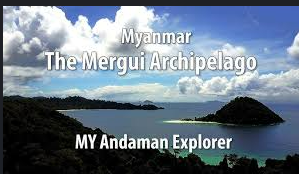
Ahla Kabar Myay (Myanmar Andaman Resort)
Ref : Pyiet Oo Aung
Ahla Kabar Myay (Myanmar Andaman Resort)
Ref : Pyiet Oo Aung
Ahla Kabar Myay (Myanmar Andaman Resort)
Ref : Pyiet Oo Aung

Dive into the beauty of the Mergui Archipelago Burma Bank, Myanmar
Source: Travelholic Diary Myanmar
Dive into the beauty of the Mergui Archipelago Burma Bank, Myanmar
Source: Travelholic Diary Myanmar
Dive into the beauty of the Mergui Archipelago Burma Bank, Myanmar
Source: Travelholic Diary Myanmar
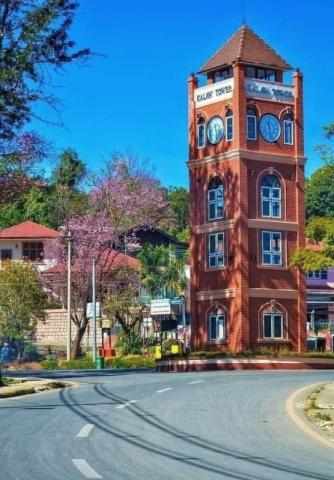
Nestled in the picturesque hills of Shan State, Myanmar, Kalaw Township is a charming destination renowned for its serene landscapes. A popular retreat to escape the summer heat, Kalaw has become a beloved spot for travelers seeking adventure, tranquility, and a glimpse into local traditions.
A haven for nature enthusiasts
Nestled in the picturesque hills of Shan State, Myanmar, Kalaw Township is a charming destination renowned for its serene landscapes. A popular retreat to escape the summer heat, Kalaw has become a beloved spot for travelers seeking adventure, tranquility, and a glimpse into local traditions.
A haven for nature enthusiasts
Surrounded by rolling hills, pine forests, and sprawling tea plantations, Kalaw offers a cool and refreshing climate year-round. The town's elevated position at 1,320 meters above sea level provides breathtaking views and a pleasant escape from Myanmar's more humid lowlands.
One of Kalaw's most magical experiences is witnessing the sea of clouds that blankets the valley during the early morning hours. As the sun rises, a mesmerizing layer of mist stretches across the landscape, creating a surreal and dreamlike atmosphere. The golden linings of the clouds create a truly heavenly scene in Kalaw. This natural phenomenon is best observed from hilltop vantage points, where the rolling clouds appear to flow like waves over the mountains and valleys below.
The natural beauty of Kalaw is best explored on foot. Trekking routes in the mountains surrounding Kalaw, one of Myanmar's most famous journeys, attract adventurers worldwide. The three-day trek winds through scenic villages, terraced fields, and forested trails, offering encounters with friendly locals from various ethnic groups, including the Danu, Pa-O, and Taung Yo.
Cultural richness and local traditions
Kalaw's vibrant market and religious landmarks reflect its diverse cultural tapestry. The town hosts a bustling central market every five days, where locals gather to trade fresh produce, handmade goods, and enjoy traditional Shan cuisine. Visitors can sample delicacies like Shan noodles, tofu salad, and other local favorites.
Prominent religious sites include the Aung Chan Tha Zedi, a beautiful gold and silver stupa, and Thein Taung Pagoda, perched atop a hill offering panoramic views of the township. The Christ the King Church, a colonial-era Catholic church, is another notable landmark reflecting Kalaw's historical influences.
Sustainable tourism and community involvement
Kalaw has embraced sustainable tourism practices, with many local guides and homestays supporting eco-friendly initiatives. Trekkers can stay in village homes, experiencing traditional hospitality and directly contributing to the livelihoods of rural communities.
Local organizations also promote responsible trekking, ensuring that trails remain clean and that visitors respect the natural environment and cultural heritage. Many trekking companies now partner with community-based tourism projects to offer authentic experiences while preserving Kalaw's pristine surroundings.
Getting to Kalaw
Kalaw is accessible by road from major cities like Mandalay, Taunggyi, and Yangon. The scenic drive along winding mountain roads offers stunning vistas of Myanmar's countryside. Travelers can also take the train from Tharzi, a route famed for its dramatic landscapes and charming local railway stations.
Tourism attractive
Kalaw Township is a destination that captivates with its blend of natural beauty, cultural heritage, and adventurous spirit. With its cool climate, relaxed atmosphere, and stunning scenery, Kalaw offers a refreshing contrast to the heat of Myanmar's lowlands. Whether trekking through lush landscapes, engaging with warm-hearted locals, or simply enjoying the cool mountain air, visitors to Kalaw will find a unique and unforgettable experience in this enchanting corner of Myanmar.
Source: NP News
Nestled in the picturesque hills of Shan State, Myanmar, Kalaw Township is a charming destination renowned for its serene landscapes. A popular retreat to escape the summer heat, Kalaw has become a beloved spot for travelers seeking adventure, tranquility, and a glimpse into local traditions.
A haven for nature enthusiasts
Surrounded by rolling hills, pine forests, and sprawling tea plantations, Kalaw offers a cool and refreshing climate year-round. The town's elevated position at 1,320 meters above sea level provides breathtaking views and a pleasant escape from Myanmar's more humid lowlands.
One of Kalaw's most magical experiences is witnessing the sea of clouds that blankets the valley during the early morning hours. As the sun rises, a mesmerizing layer of mist stretches across the landscape, creating a surreal and dreamlike atmosphere. The golden linings of the clouds create a truly heavenly scene in Kalaw. This natural phenomenon is best observed from hilltop vantage points, where the rolling clouds appear to flow like waves over the mountains and valleys below.
The natural beauty of Kalaw is best explored on foot. Trekking routes in the mountains surrounding Kalaw, one of Myanmar's most famous journeys, attract adventurers worldwide. The three-day trek winds through scenic villages, terraced fields, and forested trails, offering encounters with friendly locals from various ethnic groups, including the Danu, Pa-O, and Taung Yo.
Cultural richness and local traditions
Kalaw's vibrant market and religious landmarks reflect its diverse cultural tapestry. The town hosts a bustling central market every five days, where locals gather to trade fresh produce, handmade goods, and enjoy traditional Shan cuisine. Visitors can sample delicacies like Shan noodles, tofu salad, and other local favorites.
Prominent religious sites include the Aung Chan Tha Zedi, a beautiful gold and silver stupa, and Thein Taung Pagoda, perched atop a hill offering panoramic views of the township. The Christ the King Church, a colonial-era Catholic church, is another notable landmark reflecting Kalaw's historical influences.
Sustainable tourism and community involvement
Kalaw has embraced sustainable tourism practices, with many local guides and homestays supporting eco-friendly initiatives. Trekkers can stay in village homes, experiencing traditional hospitality and directly contributing to the livelihoods of rural communities.
Local organizations also promote responsible trekking, ensuring that trails remain clean and that visitors respect the natural environment and cultural heritage. Many trekking companies now partner with community-based tourism projects to offer authentic experiences while preserving Kalaw's pristine surroundings.
Getting to Kalaw
Kalaw is accessible by road from major cities like Mandalay, Taunggyi, and Yangon. The scenic drive along winding mountain roads offers stunning vistas of Myanmar's countryside. Travelers can also take the train from Tharzi, a route famed for its dramatic landscapes and charming local railway stations.
Tourism attractive
Kalaw Township is a destination that captivates with its blend of natural beauty, cultural heritage, and adventurous spirit. With its cool climate, relaxed atmosphere, and stunning scenery, Kalaw offers a refreshing contrast to the heat of Myanmar's lowlands. Whether trekking through lush landscapes, engaging with warm-hearted locals, or simply enjoying the cool mountain air, visitors to Kalaw will find a unique and unforgettable experience in this enchanting corner of Myanmar.
Source: NP News
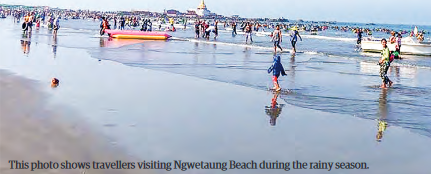
IN August 2024, Ngwetaung Beach in Ngaputaw Township, Ayeyawady Region, saw 13,555 domestic visitors, according to Daw Ni Ni Mar, an executivefrom the Myanmar Tourism Entrepreneurs Association (Ngwetaung Beach). Ngwetaung Beach is a year-round destination for domestic travellers, particularly from the Yangon and Nay Pyi Taw regions, due to its proximity to the Myat Mawtinsun Pagoda.
IN August 2024, Ngwetaung Beach in Ngaputaw Township, Ayeyawady Region, saw 13,555 domestic visitors, according to Daw Ni Ni Mar, an executivefrom the Myanmar Tourism Entrepreneurs Association (Ngwetaung Beach). Ngwetaung Beach is a year-round destination for domestic travellers, particularly from the Yangon and Nay Pyi Taw regions, due to its proximity to the Myat Mawtinsun Pagoda.
“During January, 35,455 domestic travellers visited Ngwetaung Beach, followed by 36,555 in February, 38,955 in March, 48,955 in April, 54,555 in May, 17,455 in June, and 14,155 in July. There has been a steady increase in domestic tourism, with visitors arriving throughout the year,” Daw Ni Ni Mar explained.
Ngwetaung Beach provides a peaceful and safe environment for beachgoers. Visitors can enjoy services such as bicycle and motorboat rentals, as well as horse riding. In addition, market stalls offer local cuisine, accessories, and souvenirs for sale. — ASH/MKKS
IN August 2024, Ngwetaung Beach in Ngaputaw Township, Ayeyawady Region, saw 13,555 domestic visitors, according to Daw Ni Ni Mar, an executivefrom the Myanmar Tourism Entrepreneurs Association (Ngwetaung Beach). Ngwetaung Beach is a year-round destination for domestic travellers, particularly from the Yangon and Nay Pyi Taw regions, due to its proximity to the Myat Mawtinsun Pagoda.
“During January, 35,455 domestic travellers visited Ngwetaung Beach, followed by 36,555 in February, 38,955 in March, 48,955 in April, 54,555 in May, 17,455 in June, and 14,155 in July. There has been a steady increase in domestic tourism, with visitors arriving throughout the year,” Daw Ni Ni Mar explained.
Ngwetaung Beach provides a peaceful and safe environment for beachgoers. Visitors can enjoy services such as bicycle and motorboat rentals, as well as horse riding. In addition, market stalls offer local cuisine, accessories, and souvenirs for sale. — ASH/MKKS

